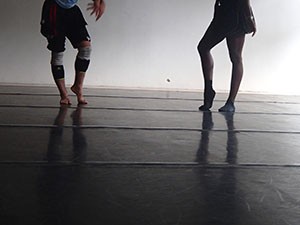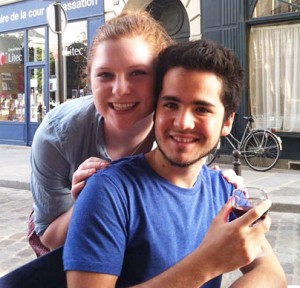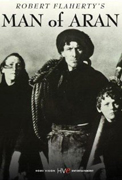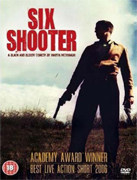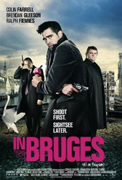“The girl spoke of love…”
 Written by Joyce DiDonato, mezzo-soprano
Written by Joyce DiDonato, mezzo-soprano
The word “masterpiece” appears often in my line of business, and while the majority of works I participate in unquestionably fall into that category, there still remains THE Masterpieces: those holy relics of unparalleled genius that have changed the course of the art form entirely. Winterreise is this singular, crowning achievement in song.
And yet, as much as I have always loved the great recital repertoire, it never once occurred to me to personally tackle this mammoth undertaking until, just over a year ago, when Yannick Nézet-Séguin approached me with the bold idea of performing Schubert’s masterful journey together. Naturally, I was compelled to give it great consideration: “But it must really speak to you”, he warned. “You must feel deeply called to enter into this world and live there for some time.”
And so naturally I dove in. Completely. And yet, diligent as I was, I couldn’t quite find my way into the protagonist’s world, despite the utterly compelling journey in front of me. It wasn’t a question of gender – I’m used to donning pants on the stage. No. Instead, a persistent question took hold of me and simply wouldn’t let go: “But what about her?” my heart kept asking.
In most writings about this cycle, authors gloss over her involvement dismissively: “We don’t know much about her,” the papers reveal, and the discussion promptly closes.

Joyce DiDonato as Charlotte with Vittorio Grigolo as Werther in Werther, Royal Opera House. Photo by Bill Cooper
Perhaps it’s my identification with Charlotte in Massenet’s Werther that kept this question front and center in my mind. (I’ve always wondered what happens to her when the curtain comes down. Does she cave in to her passion and follow Werther into his fate of suicide? Does she obediently return to her life with Albert, dutifully, yet completely hollowed-out?)
This girl — this catalyst – that prompts our protagonist to flee his life, to embark on his pilgrimage of sorrow and despair, and to journey into oblivion presumably must know of his departure. She must feel it. She must surely wonder about him … after all, she “spoke of love”. Has she mourned his loss? Has she simply gone about her life as is expected of a girl of her stature? How has she moved forward in her life?
This lingering question provided no resolution in Müller’s poetry, and so I set out to create my own story: what if He sent His last journals to Her before he parted? A tormented and painful a scenario to face, what if His final words arrived to her as a kind of suicide note? What if He wanted Her to understand Him? To feel His pain? To experience His torment and despair? To force her to wander alongside Him? And what if She reads the writings? Word for word. Over and over. (“Ces lettres … ces lettres”, Charlotte screams out.)
What happens to the winter’s journey when we feel it through the heart of the one who was the impetus of such agony and despair? The survivor. The one left behind. What does a singular event look like through the differing eyes of two separate people, two separate perspectives? The lives that have entwined so closely cannot be separated or disregarded so easily.
Perhaps one element of a true masterpiece is that it invites itself to be experienced in new light.
So what about she who spoke of love? This can also be her journey …
Hear Joyce DiDonato and Yannick Nézet-Séguin perform Schubert’s Winterreise on Sunday, December 16.
Resident Update: Writer Robert James Russell
Writer Robert James Russell is a UMS Artist in Residence this season. We’ve asked five artists from across disciplines to take “residence” at our performances and to share the work these performances inspire. Robert shares his experiences on dance, music, and his new novel below:
“When I applied for the UMS Artists-in-Residency program, my goal was to see performances and use that inspiration to craft a new novel. I’m beyond thrilled at the chance to experience wonderful performances and explore the role of music and dance in my work—both of which have always been crucial to my mental health, and to my ability to immerse myself in a project.
So far, I’ve seen the following UMS performances, all radically different from one another—and each has inspired me in vastly different ways:
- Ryoji Ikeda (superposition)
- Mariinsky Orchestra
- Compagnie Marie Chouinard
- eighth blackbird
See, this isn’t just writing a novel, coming up with a story and characters, but in this instance I am creating an entirely new place: a fictional island in Lake Superior, documenting the entire history of the island, of the people that lived (and, in the present of my novel, still live) there. Typically when I write I find some style of music that works for that story and I listen to the same record(s) over and over as I write, never growing tire of the repetition. In this instance, though, since it’s not just story, but history…and this immersion in different types of performances has been utterly liberating:
- superposition taught me, even through the wondrous noise, about the use of silence in my work.
- The Mariinsky Orchestra inspired me to embrace more bombastic/dramatic sections of the story.
- Watching the Compagnie Marie Chouinard showed me how to re-think interactions of characters, how they meet in the story, but also how these characters interact with the island itself.
- eighth blackbird encouraged me to embrace the unexpected—to travel different routes in the storytelling, in the creation of the island’s history, of its inhabitants, and to avoid the predictable…to really dig deep and do something unique.
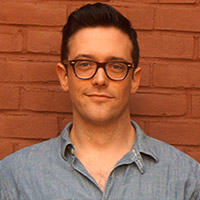 Each of these performances has taught me re-think what I know about art and inspiration, and they are with me every day when I write. In addition to a seemingly never-ending list of books I flip through daily—various back-issues of National Geographic featuring articles about Isle Royale (used as inspiration); a 1937 manual called Wolf and Coyote Trapping; the unbelievably inspiring/gorgeous Atlas of Remote Islands by Judith Schalansky; others—I am constantly harkening back to each performance, remembering them, and making sure that they are not forgotten. And I am reminded with every word I put down how astonishing and remarkable the performing arts are…how important they are to the production of any art.”
Each of these performances has taught me re-think what I know about art and inspiration, and they are with me every day when I write. In addition to a seemingly never-ending list of books I flip through daily—various back-issues of National Geographic featuring articles about Isle Royale (used as inspiration); a 1937 manual called Wolf and Coyote Trapping; the unbelievably inspiring/gorgeous Atlas of Remote Islands by Judith Schalansky; others—I am constantly harkening back to each performance, remembering them, and making sure that they are not forgotten. And I am reminded with every word I put down how astonishing and remarkable the performing arts are…how important they are to the production of any art.”
——
Robert James Russell is the author of two upcoming books: the collection Don’t Ask Me to Spell It Out (WhiskeyPaper Press, 2015) and the novel Mesilla (Dock Street Press, 2015). His first novel, Sea of Trees, was published in 2012. He is the founding editor of the literary journals Midwestern Gothic and CHEAP POP. You can find him online at robertjamesrussell.com and @robhollywood.”
Interested in learning more? Read our interview with Robert.
Student Spotlight: Keeping Up with Kyle Abraham
Editor’s note: During the summer of 2014, UMS launched a new 21st Century Artist Internships program. Four students interned for a minimum of five weeks with a dance, theater, or music ensemble that is part of our 2014-2015 season. Sophia Deery is one of these students. She spent the summer in New York with Kyle Abraham and his company Abraham.In.Motion and recounts her experiences below. Abraham.In.Motion brings their innovative choreography to UMS on March 13-14.
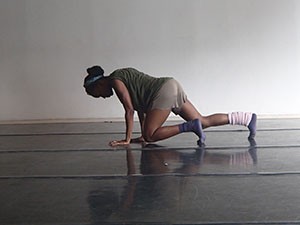
Tamisha Guy rehearses “When The Wolves Came In,” which partially draws inspiration from a tragic accident involving wild African dogs at the Pittsburgh Zoo in 2012.
“Sister Sophia!” Sister Sophia – that’s me. “Sister Sophia, could you come here and film this run?” That’s Kyle Abraham, founder, choreographer, and dancer of Abraham.In.Motion, the NYC based-dance company which emerged on the scene in 2006, and became one of the hottest tickets in the city this season with its critically acclaimed two-night program at New York Live Arts in September. I was able to intern with Kyle and the company from July through August of this past summer under the auspices of the newly created 21st Century Artist Internship through the University of Michigan’s University Musical Society. This was a fascinating time to be with the company, not only because it immediately preceded their NYC premiere of The Watershed, and When the Wolves Came In, and would involve helping to plan a major European tour, but because it was – and still is – a time when the company itself was undergoing a major internal transformation.
I came to AIM as they were nearing the end of their two-year residency at New York Live Arts. The residency is a valuable one. It allots a space and funding for a given artist to develop and perform new works in a beautiful building in Chelsea which houses a full theater, offices, and several state of the art studios. For those not familiar with New York Live Arts, it is a non-profit organization that was the result of a 2011 merger between the renowned Bill T. Jones/Arnie Zane Dance Company and Dance Theatre Workshop. In addition to this residency, Kyle had received a MacArthur “Genius” fellowship in 2013, and the company was changing shape from a pick-up model where dancers would work on a project-by-project basis, to a resident company. The difficulty is if you want dancers to make your company their priority, you have to enable them to support themselves. I had the invaluable opportunity to sit in on many meetings about budgets, the hiring of new dancers and staff members, ideas for social media campaigns, and the scheduling of performances that seemed incredibly far into the future. My own administrative tasks included writing up and sharing weekly rehearsal schedules and booking locations for the rehearsals at various dance spaces all over the city… all the while staying in budget. What I witnessed on the administrative side of the internship was, in essence, the growing pains and excitements of a small dance company, moving up to take its place as a major player in the dance landscape.
“I hope it’s good.” Kyle says to me, stretching out across the marley floor, sock-feet splayed, eating the chicken salad I had picked up for him. Rookie-intern that I am, I had made the mistake of forgetting a fork, necessitating a second trip down 6 floors and across the street, back to the deli where the cashier already thought I was crazy for spending 15 minutes trying to decide if I should get regular chicken salad, because they didn’t have the curried kind he had asked for. (The regular was fine, it turned out). I have learned a lot of things about Kyle from working as his intern. He is a very picky eater, enjoys Auntie Anne’s pretzels (original salted) and lemonade, and hates cheese. “I hope it’s good” was not referring to the chicken salad, however, but to the two programs he was rehearsing that day for their upcoming premiere. His openness and self-deprecation leave me wondering if he really cannot see the power of the piece that has left me breathless even after the tenth run. I have learned that it can be hard directing a company of dancers, now no longer all people with whom you graduated from college, but a new, younger group who look to you as a leader. He navigates a fine line between knowing when to adhere to divisions of authority structure that divide dancer and choreographer or artistic director, and when relaxing these divisions and goofing around is essential to group cohesion. I have learned that Kyle likes to send emails ending in a inscrutable “…” which leaves the recipient slightly panicked, wondering exactly what that last implied piece of information was…
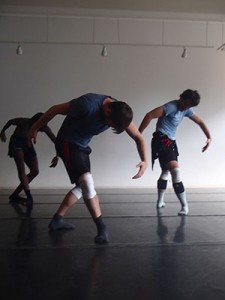
Long-time company member, and newly appointed company liaison Matthew Baker (an Ann Arbor native!) leads auditioning dancers through choreography.
“Sister Penda!” Kyle calls in a laid-back drawl, as dancer Penda N’diaye makes her way over. Kyle’s speech alternates between a familiar, affectionate, urban drawl tinged with the occasional “y’all,” which he uses with his dancers, and rapid, academic articulation when he talks about his ideas, inspirations, and influences. These are many, and indicate a cultural and artistic literacy that is wide as it is deep. Born and raised in Pittsburgh and immersed in urban youth street culture, educated at SUNY Purchase where he studied classical and modern dance, then to NYU where he received an M.F.A., a former classical cellist and briefly an employee at the Andy Warhol museum, Kyle’s education, much like his choreography, follows no conventional pattern. Additionally, he is a black, homosexual man, at a time in our country’s history where we are still deciding exactly what it means to be both. It is no doubt because of this unconventional path that Kyle’s choreography incorporates such a variety of styles (ballet, hip hop, contemporary, Graham, etc.), subject matter (Emancipation Proclamation, identity, modern sexuality, apartheid, protest), music (Max Roach, Robert Glasper, Drake, Italian Opera) – and despite the incredible breadth of its spectrum, it always rings true. Every piece comes off like a first person account of a real life experience. Like his speech, they are unaffected, but very effective.
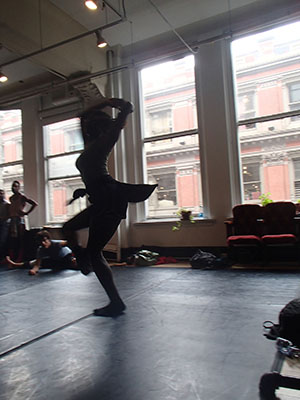
New A.I.M. dancer, statuesque Penda N’diaye, practices on the side during a rehearsal at Gina Gibney Studios.
Kyle expects this same malleability and authenticity from his dancers. His auditions, which I was fortunate enough to witness rather than experience, are a grueling process. When I asked Kyle what he looks for in a dancer, hoping honestly to get some inside-scoop for when I’m back in New York, he said that he looks for someone with dance ability and/or training across several techniques like Graham, Limon, classical ballet, Horton, hip hop, etc. As he ticked off historic dance makers and various techniques, I thought of how broad a dancer’s education has to be nowadays in order to remain competitive and successful in the field. They have to take direction which morphs technical terms like “a la second leap and then lateral T” immediately followed by “hood rat, booty poppin’, gum chewing” into “soldier walks.” This is not a one-trick pony company; indeed fewer and fewer are. Ballet company seasons are increasingly including works by Paul Taylor and Twyla Tharp, making dancers’ versatility vie with their perfect 32-count fouettés among their most marketable skills. Our conversation made me wonder what type of education provides this – how does the modern professional dancer train? I spoke with the company dancers about their various backgrounds and training, and found that many of them had pursued degrees in dance following high school, while others had immediately begun professional careers. Varying backgrounds aside, the common denominator for all of Kyle’s dancers is their intellect. The versatility he demands extends beyond the physical. As evidenced by the myriad sources from which he draws his inspiration, this is a company in which intelligence, and an understanding of the concept of each piece is essential to being able to perform it with integrity.
Two men lunge and shoot their arms up in a high V, fingers in a gesture suggestive of an old time cowboy at a gun show, or perhaps a gang member throwing up his allegiance, but the hands don’t stop there and move immediately into a high fifth position which then travels down the body to first position while their torsos synchronize in a liquid body roll. In my favorite piece, a trio called Hallowed, gospel music fills your ears as you watch three dancers alternate between a slow strut, lazily waving their arms with deadened eyes – and the rapid, aggressive arm gestures of a dance-off, eyes alive with anger or indignation. The first conjures images of paper fans, of hard church benches, of heat, and perhaps a more sinister oppression. The contrast between the two styles of movement seems to me a dramatization of the tension existent between resignation and protest.
These few examples show some of what makes Kyle Abraham unique as a choreographer: there is a story – told in recognizable pedestrian movements which are generic only in the sense that they are universal and recall things the audience has experienced, wished, or feared. Sketched situations of human existence, they allow us to do some coloring in. Seamless transitions from the pedestrian, to modern dance vocabulary, to hip hop and social dance, give the impression that Kyle is not so much juxtaposing contrasting styles of movement, or worlds for that matter, but rather elegantly weaving them together in a new type of concert dance. This is not schoolyard hip hop, nor a purist’s classical dance. While it incorporates elements of both, it also has roots in the real, the commonplace, the grit and injustice, problems we have faced in the past, and those we are grappling with now, and yet simultaneously it transcends them. At once personal and universal, and never more timely, the pair of The Watershed and When the Wolves Came In is like a diary entry written in the curves of spines, the bends of elbows and shifting patterns of light.
To view more of Sophia’s photography, see the gallery below.
Student Spotlight: Could You Repeat That? and Other Stories from Paris
Editor’s Note: Clare Brennan is a junior at the University of Michigan. This past summer she interned for ANRAT, a theater research company in Paris co-founded by Emmanuel Demarcy-Mota, director at Théàtre de la Ville. Their production of Pirandello’s Six Characters in Search of an Author comes to UMS October 24th and 25th.
The summer of 2014 consisted mainly of getting lost. As a first-timer to the grand city of Paris, or to any sort of international travel for that matter, I had incessantly practiced the correct way to ask for directions to the bus stop during my entire eight hour flight. Before I could get a “Bonjour” in edgewise, a bored flight attendant directed me towards my destination in perfect English, and I was on my way.
I’d gladly forget my first trek from the airport to the dorms, dragging my two oversized suitcases across town, but after the jetlag wore off, I started to get the hang of things. I became a lover of maps, discovering the metro system as quickly as possible. That knowledge invariably went out the window as soon as summer construction began. Eventually, I started ending up in the same places, and what was once a completely strange conglomerate of streets started feeling a little more like home.
Once settled in, I dove into the incredible wealth of theater surrounding me. With over 150 professional theaters within its city limits, Paris never let quantity deteriorate quality. One of my first shows was Ionesco’s Rhinocéros at Théàtre de la Ville. I had missed the production when it came to UMS last season, and was so excited when fellow UMS intern Flores Komatsu offered up a ticket to join him. We met at the theater and crossed one of the many bridges that connect the vastly different banks of the river to find a small café for dinner. A group of men of various ages played pétanque, the French equivalent of bocci ball, on a dirt patch next to us, a common pastime on summer evenings. Obviously American, we prattled away, catching up on upcoming projects, book recommendations, and travel plans. Eventually, the couple from Colorado sitting next to us struck up a conversation, and after twenty minutes we had learned the story of their ex-pat daughter and swapped recipes for favorite dishes we’ve discovered. Caught up in conversation, we barely realized we were running dangerously close to curtain time. We sprinted back to the theater and found our seats with just enough time to absorb the atmosphere.
*
I love theaters. Between their velvet curtains and cushioned seats, both actor and audience member gain some security to suspend their disbelief for a while and hear a story. I appreciate that sense of trust that seems built into the walls, and I always try and find it again before every show I see.
At Théàtre de la Ville, the most striking quality I found was its size, housing around 1,500. Our Monday evening show was sold out, and as I looked around, I noticed that most of those in attendance were around my age. In my exploration of the arts at home, I’ve often found truly invested younger patrons more difficult to find. There, young people come to shows, stay for talkbacks, and attend season premieres; Théàtre de la Ville’s season announcement, for instance, packed the house just as tightly as their best-known runs.
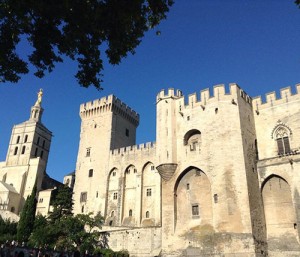
Photo: Le Palais de Pape, where “I Am” played during the Avignon Theater Festival in July. Photo by Clare Brennan
The house lights dimmed, and I experienced again what would quickly become one of my favorite culture moments abroad. Before an actor ever sets foot on stage, a score of audience members will audibly shush one another. It will be hard to forget my first experience of this sort, as the majority of hisses were directed at me. Foreign air and a lack of sleep had left me sick for a couple weeks, and, apparently, I thought that the start of the Moroccan acrobatic performance Azimut at Théàtre du Rond Point would be a lovely time for a coughing fit; the surrounding patrons did not. I quickly picked up this less-than-subtle social cue, and by the end of my two months, I was joining in as passive-aggressively as possible. Strong reactions like this were never out of place. At the Avignon Theater Festival, a production of Lemi Ponifasio’s I Am, a World War II homage in dance, produced critical laughter, side comments, even a small exodus after a particularly difficult movement. However, with this piece included, I also never saw a performance without at least five minutes of applause at the close.
*
Seeing theater in a foreign language took a bit of adjustment. Rhinocéros opens with a beautiful monologue. I couldn’t tell you what the first few lines mean now, as I was still looking for surtitles within the first few moments before I remembered where I was. I did have opportunities to try reading French surtitles during a Dutch production of Ayn Rand’s The Fountainhead and a Japanese kabuki style of the Mahabharata. Reading and translating French while listening to another language with which I had no experience left my American brain a little withered, but it did help me to abandon any pretenses I had when I arrived and dedicate a couple of hours to a completely new experience. Or four and a half hours, in the case of the Dutch Fountainhead. (I have to admit, I dozed off for about twenty minutes of that. I read the book in high school, so that counts, right?)
That night, Flores and I left the theater and lingered on the rainy sidewalk with a crowd of theatergoers doing the same. We all shared our thoughts, compared interpretations, raved over actors, and tried to weave our way through the denser moments. We said our goodbyes for the night, and as I turned to leave, I realized that I was pretty disoriented. I was lost in Paris again, but what else was new. Theater abroad left me dizzy and buzzing, not quite sure of where I stood but happy that I was there. I was used to the feeling by now, and there could be worse places to get turned around. Paris is a city for wandering, anyway.
Tweet Seats: Esperanza Spalding
On to our fourth tweet seats event! This time we saw Esperanza Spalding perform at Michigan Theater on April 6.
Meet the participants.
UMS: Tell us a little about you.
Richard Retyi: I am the social media director at Fluency Media, a digital marketing agency in Ann Arbor, as well as a regular feature writer for AnnArbor.com, Concentratemedia.com and other publications. You can follow me on Twitter at @RichRetyi or read my work at RichRetyi.com.
Cody Takacs: I am a recent graduate of the School of Music earning my BM in Double Bass Performance. I appear frequently as a soloist specializing in new music with performances ranging from the University of Michigan’s Collage Concert to Carnegie Hall. As an educator, I have been the double bass instructor for Skyline High School’s orchestra and chamber music coach for Michigan Bass Bash.
Kristin Kurzawa: A graduate of the University of Michigan School of Art and Design (MFA 2009), I describe myself as a storyteller, innovator, and educator with a passion for bringing communities together through information sharing and online platforms. Photography, feature writing, content management, and social media community management/development are the tools I use to create user-friendly content and foster communities. My website is www.kristinkurzawa.com, and follow me on Twitter: @kriskurzawa, on Instagram at instragram.com/kristinkurzawa, and LinkedIn: linkedin.com/in/kristinkurzawa
Jasmine Hentschel: My relationship with UMS started back in my sophomore year at U of M, when I started interning in the production department. It was one of the most enriching, enlightening, and greatest learning experiences not only of my undergraduate career, but of my entire life. I currently work for Cambridge Michigan Language Assessments making standardized English language tests, and I’m headed to U of M’s School of Information to study computational linguistics in the fall. @JasmineShuree on Twitter.
UMS: In one sentence, how would you describe your relationship with technology?
Richard Retyi: The only reason I am in social media is because I signed up for Twitter back in 2007 on a whim. Since then, I’ve been kind of tethered to my phone. All the world’s knowledge in a single device, plus Instagram.
Cody Takacs: I use technology to build and maintain a strong musical network and also to share and express my musical ideas.
Kristin Kurzawa: As a self-proclaimed geek, I appreciate the technology in every tool I use throughout the day, from my anti-glare eyeglasses to my ubiquitous iPhone to the latest cloud-based software.
Jasmine Hentschel: I am wonderfully overwhelmed by the incredible knowledge and power that technological advances of recent decades have afforded people all over the world.
UMS: Why did you decide to participate in this project?
Richard Retyi: Curiousity.
Cody Takacs: As I mentioned in the second question, I like to use technology to share and express my musical thoughts and ideas. I feel that the Tweet Seats project would allow me a great opportunity to relay my thoughts and ideas to my musical network and even public at large.
Kristin Kurzawa: I love the idea of bringing digital communities and live, in-person communities together. I’m 100% committed to increasing awareness of the arts! The Tweet Seats is one of the most innovative and exciting ideas for involving everyone in the experience!
Jasmine Hentschel: I think UMS is an incredible organization that really brings a great deal of phenomenal art and culture to the vibrant city of Ann Arbor. Having worked as an intern for several years in the production department, I’ve been to dozens and dozens of UMS shows and I thought this would be an exciting new way to get involved. I am very curious to see how it feels to be engaged in the performance in a totally different way.
UMS: To you, what does it mean to “be present” during a performance or another arts experience?
Richard Retyi: I think unless you really know a particular sphere of art or performance (musicians, dancers, etc.), performances transport your mind somewhere else most of the time. You watch the musicians, you watch the artists and then your mind wanders. To past memories, creative ideas, whatever. And then you return to what’s actually happening. Or maybe that’s just me.
Cody Takacs: To be “present” at a performance to me means 1) that the listener is physically present and 2) that they are mentally experiencing the performance on one or a combination of any of Aaron Copland’s three planes of listening that find best suiting for their own listening experience (the sensual, expressive, and sheerly musical planes).
Kristin Kurzawa: To me, “being present” involves all five senses. The ability to really observe both the micro and macro level of the entire experience- from the smell of the auditorium, to the sounds of the orchestra’s warm-up, to the visual impact of the set design or audience reaction, to the feel of the velvet seats beneath you– to the taste of the fountain soda during intermission!
Jasmine Hentschel: Being “present” is a matter of being engaged in a performance and giving it all of your consideration and attention, regardless of your preconceived notions and expectations of what it might be. It’s about not only noticing the little things, including all of the time and effort that gets put into every aspect of a performance, but also how it makes you feel before, during and after, and how you the art you’re watching ties into and relates to your personal experiences and those of all of mankind, whether it be theater, dance, music, or some other art form.
Meet the tweets.
After the performance
UMS: How did tweeting affect your experience of the performance?
Kristin Kurzawa: I thought the tweeting experience might be a wee bit distracting to my focus, but it was just the opposite. Knowing that I was the eyes and ears of the concert for those following kept me hyper-focused on the band, the audience, and of course, Esperanza Spalding’s voice!
Jasmine Hentschel: I was so mesmerized by Esperanza and the band throughout the entire performance that it was hard to decide when to take my eyes off them to post a tweet. However, tweeting about the performance also forced me to analyze how I was thinking and feeling in a very different way than I normally would during a show, to determine exactly why I was so mesmerized, and to put these thoughts and feelings into comprehensible words. It’s interesting to have the tweets now to look back on after the fact, to recall what I was thinking at very specific moments throughout the performance that I would totally forget about otherwise.
Richard Retyi: Working in athletics and live-tweeting a number of games for work, the experience wasn’t new to me. With the hashtag, I was more curious about what my fellow tweet seaters were saying, so it was like the four of us were having mini conversations during the performance.
UMS: Did you expect this effect or are you surprised by this outcome?
Kristin Kurzawa: I enjoyed meeting and sharing tweets with my fellow Tweet Seaters. We represented such unique perspectives that we created a team. I would love to see us have more dialogue during or after the shows, but that would take a lot of multi-tasking for sure.
Jasmine Hentschel: I honestly thought it would be a little easier because I anticipated there being at least a couple lulls in the performance. But every song was completely engaging and I found it hard to take my attention away from the stage even for a few moments. It was definitely easier than tweeting during a Shakespeare play though, because I could still hear the music and follow the show without a problem even when I was on my phone–trying to do that during a play meant I had to look up and jump back into the show after missing dialogue and action that you can’t take in if you’re looking down. That was right along the lines of what I expected.
Richard Retyi: I didn’t really know what to expect going in. I should have known that the hashtag wouldn’t be in use during the performance by the people in the theater. I’d be curious about the response from tweet seaters in the overall UMS community.
Are you interested in joining our tweet seats section? Sign up & we’ll let you what’s coming in the 2013-2014 season.
Student Collaborations at The Kennedy Center
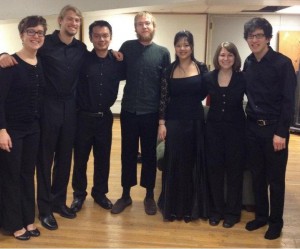
From Left to Right: Martha Cargo, Jordan Brooks, Eric Siu, Erik Haasler, Rimbo Wong, Kari Dion, Lee Dionne.
A few weeks ago, I traveled to Washington D.C and had the pleasure of playing with musicians spanning the entire country. The University of Michigan participates annually in the Kennedy Center’s conservatory project, for which college students from around the country are brought together to collaborate.
This year, Three Cities Marathon project showcased new and contemporary music from recent composers. I was ecstatic to be U-M’s nominee this year; I had always admired the Kennedy Center’s commitment to young artists, but I never thought I would get to be a part of it.
I had never been to Washington D.C before, so after I arrived, I immediately wanted to see the sights. I walked around Georgetown and through the monuments, admiring the city. Finally on Saturday morning, I met and rehearsed with my fellow student musicians from around the country.
The piece I was invited to perform was Martin Smolka’s Die Seele auf dem Esel (The Sole on the Donkey) for Piccolo, Eb Clarinet, Cello, Viola, Violin, Percussion, and Piano; non-traditional as far as instrumentation goes.
The piccolo player was Martha from Manhattan School of Music, the cellist was Erik from San Francisco, Rimbo was the violist from the Cleveland Institute of Music, the violinist was Eric from Rice, the percussionist was Jordan from Berkley, and the Pianist was Lee from Yale. Seven extraordinary musicians, yet, our piece was very hard to put together.
When modern music is notated, it tends to be more ambiguous and exceedingly more complicated metrically, making rehearsal’s very difficult. My part actually instructed me to play certain notes however I wanted to, for any duration, until the “rain stick” decided to stop. So crazy!
We had very little time to put the piece together; the rehearsals were Saturday, and the performance was Sunday afternoon. But, despite the complicated notations and the shortness of the stay, the performance was a wonderful experience. Having the pleasure to play with such great musicians who have the ability to hear and react perfectly to everything was very special.
The other composers featured on the concert were Johannes Maria Staud and György Kurtág. Probably the most memorable piece from the whole concert was Strad’s work Incipit II for trombone and bass drum. This seems fairly normal, however, Strad’s piece is meant to be played by one person. The performer is instructed to play a kick drum, the trombone, as well as scream and grunt during the piece. It was one of the most involved solo works I had ever heard; it was brilliant!
Playing Eb clarinet has always been very fun for me, but I had never imagined it would take me so many different places. Being part of the Three Cities Marathon project was especially fun. Seeing a new city, performing new music, and connecting to more wonderful musicians; thanks so much U of M for the opportunity.
Check out the link to the performance!
— Kari Dion is a U-M Master’s Clarinet student and UMS Digital Media Intern. She is also part of Akropolis quintet.
Public Q&A: Ask Stile Antico
When the young British ensemble Stile Antico performed two years ago, the event was one of the most talked-about that season.
The ensemble is now firmly established as one of the most original and exciting new groups in the choral music world. Working without a conductor, the 12 members of Stile Antico rehearse and perform as chamber musicians, each contributing artistically to the end result. Their performances have been repeatedly praised for their vitality and commitment, expressive lucidity, and imaginative response to text.
Now’s your chance to ask the musicians your questions. Tweet your questions @UMSNews, post them on our Facebook page, or in the comments below.
We’ll post Stile Antico’s response here on the Lobby before they return to perform again on December 7.
Delinquent Dispatch from Fringe
Image: The Simple Things in Life
 My sincerest apologies…I’m a little delinquent here with my second “dispatch.” I was operating at a fairly severe sleep deficit for a bit there. But I’m back and ready to share some last highlights from a whirlwind trip to my favorite European city (a title I’ve also been known to bestow on Budapest when I want to sound a little more exotic).
My sincerest apologies…I’m a little delinquent here with my second “dispatch.” I was operating at a fairly severe sleep deficit for a bit there. But I’m back and ready to share some last highlights from a whirlwind trip to my favorite European city (a title I’ve also been known to bestow on Budapest when I want to sound a little more exotic).
Best Thing Ever
On Tuesday, I saw the best thing ever. I’ll be the first to admit that I tend to speak in hyperbole at times. And I’ve generally tried to temper my enthusiasm (or lack thereof) for the purposes of work-related blog posts. So, with that initial caveat, I hereby reaffirm my initial statement and proclaim 1927’s “The Animals and Children Took to the Streets” as The Best Thing Ever. 1927 is a UK-based company that mixes live music, performance, and animation. Inspired by silent film, this piece has a “live” cast of three actors interacting with animated ones, including a posse of really, really poorly-behaved children, a horde of cockroaches, and cat named Mr. Meow, all residents of a decrepit tenement block known as “the Bayou.” It’s very rare that I’m able to fully disengage with the world around me and lose myself in an experience, but this performance was so cleverly and expertly choreographed that I actually felt a little like I was trapped in a cartoon. Rest assured that I’ll be badgering a certain Director of Programming ‘round these parts to consider this one for possible inclusion in a future season.
That National Theatre
On my last day in Edinburgh, I managed to squeeze in one more show and “experience” before rushing (understatement) to the airport. (I admit—I harbored a secret hope of not making my flight and being granted an extra night in the city.)
I made my way to the Traverse Theatre to see another National Theatre production. Not the National Theatre (of London, whose delayed broadcast screenings UMS presents throughout the season in partnership with the Michigan Theater), nor the National Theatre of Scotland (whose “Strange Undoing of Prudencia Heart” I espoused in my last post). This time, it was the National Theatre Wales and their production of “The Dark Philosophers,” an adaptation of the life and stories of Welsh writer Gwyn Thomas. Gwyn wrote some dark stuff, most of it tinged with a humorous edge. The setting for this piece is a Welsh mining community, the mountain referenced throughout represented by a plot of wardrobes, dressers, and the like. The tone of the play reminded me a bit of Martin McDonagh’s “Cripple of Inishmaan” performed here last season by the Druid Theatre Company. Previously unfamiliar with Gwyn Thomas (as I was with Martin McDonagh), I wasn’t sure if was I allowed to laugh. I wanted to. The knowing audience around me eventually did. And, similar to “Cripple,” I was left with a sense of the insular nature of a community mostly isolated from those surrounding it—the character and cadence of the local life different from anywhere else.
The Simple Things in Life
The last thing I went to was “The Simple Things in Life.” Housed in the Royal Botanic Garden, five artists were tasked with creating an experience celebrating the simple things in life, each to be housed within a small shed. The goal: to create “a haven within the hubbub of the festival.” First stop: “Lost in Words.” This shed, created by Lewis Gibson, was an exercise is looking (through viewfinders), listening (to calming soundscapes), and reading (a weaving of text excerpts from famous stories…Moby Dick, The Tell-Tale Heart, The Nightingale and the Thorn). It was a nice reprieve from the inner voice inside my head, a constant companion that at the time was worrying/hoping I was going to miss my upcoming/looming flight.
Snorkelling Team
The journey ended at the London Snorkeling Team’s shed, the location of The 2011 Annual Science Demonstration and Space Fête. The London Snorkelling Team are funny fellows. Funny fellows that play music and draw cartoons that are projected and “animated” on a standard-issue classroom overhead projector. You know, the kind used in the olden days. Audience members were given a glimpse into the workings of an interesting new take on a particle accelerator. Not one tasked with answering the greatest mysteries in the Universe, no. In this instance, the particles to be collided included a pig and a cow, the intended result being a shower of meat. Ludicrous and fun. Just like the animated fight between Carl Sagan and Stephen Hawking. As good a place as any to end things.
Dispatch from Fringe
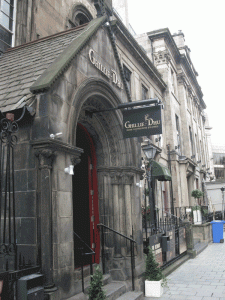 Oh goodness me! I’m back in Edinburgh! During the Fringe! The largest arts festival in the world! It’s been 9 years exactly since my last (and first) visit, when I came as part of the American High School Theatre Festival. A recent high school graduate at the time, I was tasked with running the light board for a musical version of the Ugly Duckling called Honk! Yikes! (This is reminding me that my 10 year high school reunion is nigh. Double yikes!!)
Oh goodness me! I’m back in Edinburgh! During the Fringe! The largest arts festival in the world! It’s been 9 years exactly since my last (and first) visit, when I came as part of the American High School Theatre Festival. A recent high school graduate at the time, I was tasked with running the light board for a musical version of the Ugly Duckling called Honk! Yikes! (This is reminding me that my 10 year high school reunion is nigh. Double yikes!!)
I arrived only yesterday, but I feel like I’ve been here for ages. That’s what happens when something literally takes over a city. If you’ve never been, the Fringe is to Edinburgh as a football game at the Big House is to Ann Arbor. But sustained for a month! The energy is at an all-time high from morning ‘til, well, it never stops!
I’ve seen exactly 8 shows as of now, 11:37pm local time, Monday, August the 22nd. 6 of them today. Yes. 6. And some of them more “experience” than “show.” Here’s a little taste.
The first show I saw was the National Theatre of Scotland’s The Strange Undoing of Prudencia Hart at the Ghillie Dhu, a local pub. Written by playwright David Grieg, the story follows an uptight academic named Prudencia as she travels out of town for a conference, and learns to loosen up along the way. How this happens is the crux of the action, the fun, and the heartache, some of which can be seen in this youtube video. The National Theatre of Scotland has had some hits on their hands as of late—most recently in the U.S. with their production of Black Watch. If the buzz surrounding this one at the Fringe is any indication, you just might see this one at a pub near you. I sure hope so.
Today’s marathon of shows included the premiere of a work in progress called A Reply to Kathy Acker: Minsk 2011 by incendiary political theater-makers, Belarus Free Theatre. BFT was founded in 2005 by a husband and wife team in response to the pressure and censorship of Europe’s last surviving dictatorship. Under constant threat of persecution, the group’s rehearsals and performances are often held in secret , and have at times been broken up by police. In their short history, members of the company have faced harassment, beatings, and even arrest. In this piece, the audience was given a glimpse into Minsk today from the artists’ perspective. And it was, in a word, brutal. They’re a brave group. And their acting is likewise brave. It’ll be interesting to see how the work develops.
Later in the evening, I was able to catch David Leddy’s newest work called The Untitled Love Story. Some of you may remember David’s Susurrus made an appearance in Ann Arbor this past year out at Matthaei Botanical Gardens. Though this piece was housed in a more traditional theatrical setting, the hallmarks of David’s style of writing rang loud and clear. His knack for weaving seemingly disparate storylines into one cohesive production is astounding and the story all the more powerful because of it. And, as with Susurrus, the use of music is crucial—and used to great effect. Here are the basics: the setting is Venice. The characters are known only as the Collector, the Historian, the Priest, and the Writer—two men and two women who have all suffered/will come to suffer great loss. It’s not all sad though! I promise!
The night ended with a short 15 minute “live video” experience for one called And the Birds Fell From the Sky by Brighton-based Il Pixel Rosso. In a nutshell, I joined a group of nomadic criminal clowns (collectively known as the Faruk) for a car ride. Crimes were committed. Birds fell from the sky. I was supremely freaked out. And I totally loved it. Logistically, it involved an impressive pair of video goggles synced up with an in-ear audio track. An actor unseen to the audience member provided the other tactile sensations—smells, touch, movement . All in all, a deep and bizarre Fringe experience. The best kind.
* * *
Have you been to the Fringe? Are you at the Fringe now? Share your experiences below.
Hill Auditorium is turning 100! How should we celebrate?
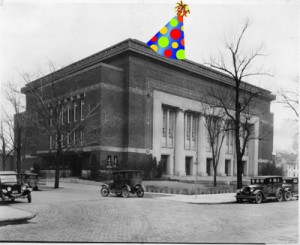 We want to know what you find interesting and important about Hill Auditorium.
We want to know what you find interesting and important about Hill Auditorium.
The 12/13 season is Hill Auditorium Centennial Season (the venue opened in May 1913 with a concert by the Chicago Symphony as part of that year’s May Festival), and we’d like to know how you think we should commemorate the occasion.
Is there a particular artist or program you’d like to see? A story of a memorable concert or event at Hill that you’d like to share?
What makes Hill Auditorium HILL AUDITORIUM?
Merce Cunningham Dance Company in Ann Arbor (Recap)
For those who enjoyed the Merce Cunningham Dance Company’s final UMS appearance in February, don’t miss this recap of all the residency activities the company participated in while they were in Ann Arbor.
Septeto Nacional’s Dance Party Extravaganza
With a rich history firmly rooted in the dance floor explosion of son that took place in the 1920s and 30s, Septeto Nacional de Ignacio Piñeiro de Cuba have been hailed as the “inventors of salsa” (The New York Times) and “national treasures” (The Boston Globe). The band certainly got the audience moving when they played Hill Auditorium on April 7, 2011. And thanks to some pre-show instruction from the University of Michigan’s M-Salsa team, some of us actually had some fancy footwork to flaunt. Take a peek at M-Salsa’s mini-lesson, which took place at one of our pre-show U-M student events, Arts & Eats, and see if you can’t pick up some sassy moves of your own.
11/12 Series Brochure – view the digital version!
We’ve Got a Scorcher on Our Hands!
Audiences in Boston are Raving about Martin McDonagh’s
The Cripple of Inishmaan!
“The big word I’d use to describe ‘The Cripple of Inishmaan’ is wonderful.”
–The Boston Globe
“… [a] fiendishly funny sendup of rural Irish life…
McDonagh’s people are as irresistible to us as they are nasty to one another.”
–The Washington Post
Check out this note from the executive director of Arts Emerson: The World on Stage, which presented the play in Boston last month:
Dear Michigan Audiences,
I’m writing to tell you that you are in for a huge theatrical treat this week! We hosted the Druid and Atlantic Theater Company’s production of The Cripple of Inishmaan last month here in Boston, and our audiences absolutely adored it. Martin McDonagh uniquely combines the wit and humor for which the Irish are legendary with a charismatic storytelling ability. Few plays have the variety of “characters” – and I mean that in both the ironic sense and in the sense of fully-realized character development – of this play. You can see what our audiences had to say about it here:
I’m still receiving comments from our audiences about how much they enjoyed the work – and also messages of regret from people who weren’t able to see it during the short time that it was in Boston. There’s nothing I hate more as an arts presenter like UMS than having something in my venue for such a short time that people don’t know about it until it’s too late. I hope you will check it out while it’s in Ann Arbor – trust me, you won’t want to miss it.
Sincerely,
Rob Orchard
Executive Director, ArtsEmerson: The World On Stage
Martin McDonagh on the Big Screen
Next week UMS welcomes the Druid Theater Company from Galway Ireland to Ann Arbor with their Martin McDonagh– scripted/Garry Hynes-directed play, The Cripple of Inishmaan. To say I’m excited is about as pointless as debating the delectability of that other magical Irish import Guinness! It goes without saying.
In advance of the performances, the U-M Residential College Drama Department is screening a few related films that we hope you can check out if you get the chance. All screenings will take place in the RC Keene Theater located in the East Quadrangle Dormitory and are free and open to the public.
Sunday, March 6, 7pm: Man of Aran
This 1934 documenty film by Robert J. Flaherty follows everyday life on the Aran Islands located off the coast of Ireland, and, at least partially, inspired The Cripple of Inishmaan which is set (at the time of the documentary’s filming) on the largest of the Aran Islands, Inishmaan. This screening will be preceded by a short performance from local Celtic music ensemble, Nutshell.
Tuesday, March 8, 7pm: Six Shooter and In Bruges
Although he might be better known as a playwright, Martin McDonagh also wrote and directed two films: the live action short, Six Shooter (2005, 27 minutes, Rated R, starring Brendan Gleeson, Rúaidhrí Conroy, and David Wilmot), and the full-length feature, In Bruges (2008, 107 minutes, Rated R, starring Colin Farrell, Brendan Gleeson, and Ralph Fiennes).
Six Shooter, his first film, won the 2006 Oscar for best live-action short. This black comedy follows a man named Donnelly (Brendan Gleeson), whose wife has just died, on an increasingly bizarre train ride in Ireland [in which] he meets a young couple whose infant has also just died, and a nameless young man with a warped sense of humor and an explosive secret (synopsis from the New York Times).
In Bruges, the opening night film of the 2008 Sundance Film Festival, is a black comedy crime film starring Colin Farrell and Brendan Gleeson as hitmen in hiding, with Ralph Fiennes as their gangster boss. The film takes place and was filmed in the Belgian city of Bruges. Colin Farrell won a Golden Globe Award for Best Actor in a Musical or Comedy for the film, while Martin McDonagh won a BAFTA Award for Best Original Screenplay. You can view the trailer below.
Does where you sit affect how you feel about a performance?
Earlier this month, the New York Times published a really interesting series of articles that tackled the question, “does where you sit affect how you feel about the performance?” In the series, four NYT dance critics give their take on different views of a City Ballet performance in New York City’s David H. Koch Theater: the chief critic Alastair Macaulay in the first ring, critics Roslyn Sulcas and Gia Kourlas in orchestra, and Ms. LaRocco from her view three rows from the very top of the theater. (Check out the NYT series here: parts one, two, and three.)
The UMS Student Board was inspired to take a similar look at the views from Ann Arbor’s Power Center, using the February 18th & 19th Merce Cunningham Dance Company performances as their lens: Cathy Cao near orchestra, Rheme Sloan in center balcony, and Lena Cintron on the main floor. Read on for a snapshot of the view from their seats and tell us: where do you prefer to sit?
 CATHY CAO: I was very happy to see the seat on my ticket (section 5 row Q, seat 10), because I always love sitting at the partial view seats along the sides of the orchestra section. It excites me to see into the wings, and watch as dancers prepare before their entrance onto stage. Once on stage, a dancer has a projected presence of playing a part or a role, however seeing them backstage feels intimate. It feels like I am sharing in that private moment with the dancer, as she/he is about to burst onto stage; I am sharing in that moment of held breathe, of anticipation and excitement, of passage from a regular person to the character she/he is about to dance on stage. Cunningham’s “Squaregame” is the perfect example, since all the curtain dividers were raised. The dancer’s behind-the-stage-activities were all fully exposed to me as were the brick walls, folded sets, and extra equipment scattered haphazardly that were usually hidden behind the velvet black divider. I was more than willing to give up my vision of a small corner of the stage when I was able to share in so much more.
CATHY CAO: I was very happy to see the seat on my ticket (section 5 row Q, seat 10), because I always love sitting at the partial view seats along the sides of the orchestra section. It excites me to see into the wings, and watch as dancers prepare before their entrance onto stage. Once on stage, a dancer has a projected presence of playing a part or a role, however seeing them backstage feels intimate. It feels like I am sharing in that private moment with the dancer, as she/he is about to burst onto stage; I am sharing in that moment of held breathe, of anticipation and excitement, of passage from a regular person to the character she/he is about to dance on stage. Cunningham’s “Squaregame” is the perfect example, since all the curtain dividers were raised. The dancer’s behind-the-stage-activities were all fully exposed to me as were the brick walls, folded sets, and extra equipment scattered haphazardly that were usually hidden behind the velvet black divider. I was more than willing to give up my vision of a small corner of the stage when I was able to share in so much more.
Cathy Cao is a Junior at University of Michigan’s Residental College, studying Dance History and Cultural and Community Development. In her free time she likes to see as much dance as possible and practice some herself.
 RHEME SLOAN: I watched Friday’s Performance of the Merce Cunningham Dance Company from the center section in the balcony. In “Squaregame” I could see the shapes in the choreography. The spatial setting that Cunningham created was clearly defined because each corner of the dance floor was visible from my seat. I thought that the cross floor patters the dancers executed were clear and precise throughout. Having such a clear view of the entire stage was a great advantage to enjoying this piece.
RHEME SLOAN: I watched Friday’s Performance of the Merce Cunningham Dance Company from the center section in the balcony. In “Squaregame” I could see the shapes in the choreography. The spatial setting that Cunningham created was clearly defined because each corner of the dance floor was visible from my seat. I thought that the cross floor patters the dancers executed were clear and precise throughout. Having such a clear view of the entire stage was a great advantage to enjoying this piece.
“Split Sides” was also wonderful based on the fact that I could see all that was happening on stage. Although I couldn’t see the tops of the backdrops, the view of the dancers was incomparable. Especially in ensemble work like Cunningham’s, balcony seats are the definite way to go.
Rheme Sloan is a first year Voice Performance student in the School of Music, Theater, and Dance. Although he is studying voice, he loves experiencing all performing arts and culture.
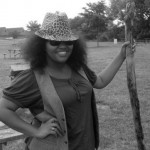 LENA CINTRON: I was in the middle of the second row and the view was spectacular. I could literally see the sweat dripping from the dancers and watch their breathing. In “Squaregame,” when the stage was stripped bare, I could see the dancers in the wings stretching and preparing to come to the middle of the stage. This seat was ideal, no movement was missed. In the second half, when the curtains were up again, dancers seemed to float onstage from nowhere and float away just as easily. For both dances I felt like I was seeing exactly what I was supposed to and missing anything that subtracted from the power of the dance.
LENA CINTRON: I was in the middle of the second row and the view was spectacular. I could literally see the sweat dripping from the dancers and watch their breathing. In “Squaregame,” when the stage was stripped bare, I could see the dancers in the wings stretching and preparing to come to the middle of the stage. This seat was ideal, no movement was missed. In the second half, when the curtains were up again, dancers seemed to float onstage from nowhere and float away just as easily. For both dances I felt like I was seeing exactly what I was supposed to and missing anything that subtracted from the power of the dance.
Lena Cintron is a student at the University of Michigan studying Linguistic Anthropology and Creative Writing. Her favorite thing about Ann Arbor is the access to great performing artists.
So tell us, where do you like to sit?



